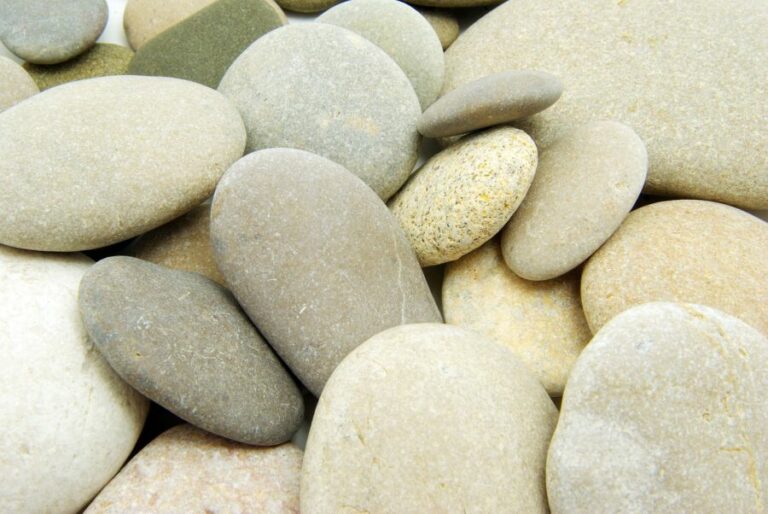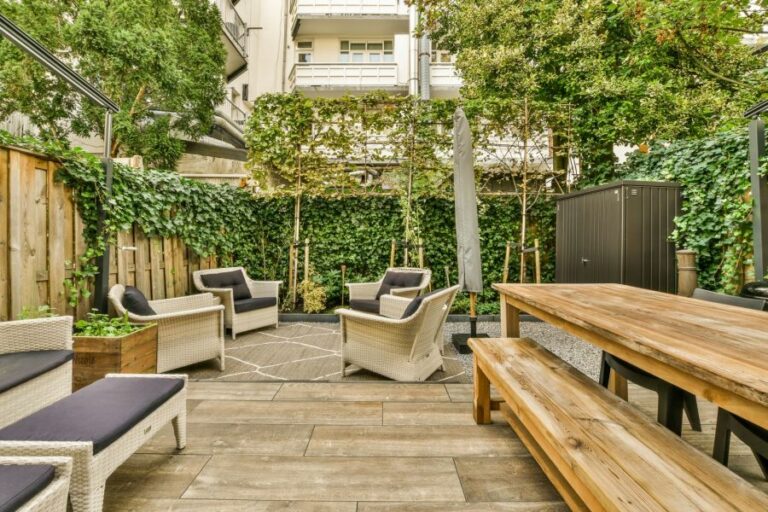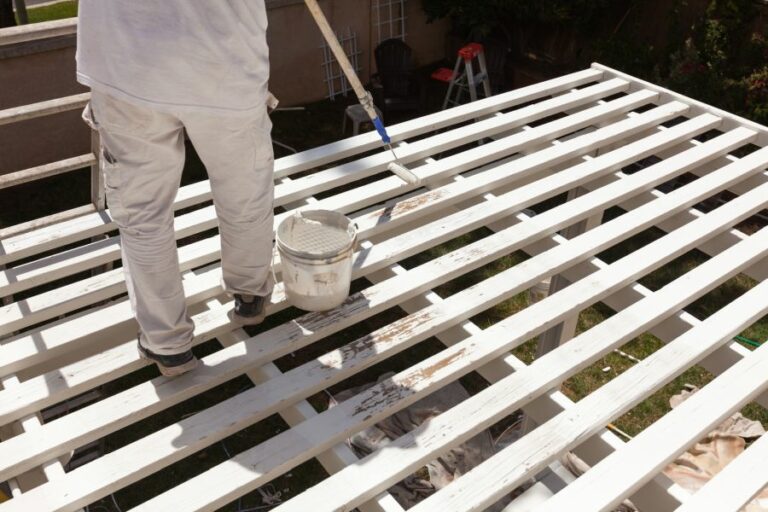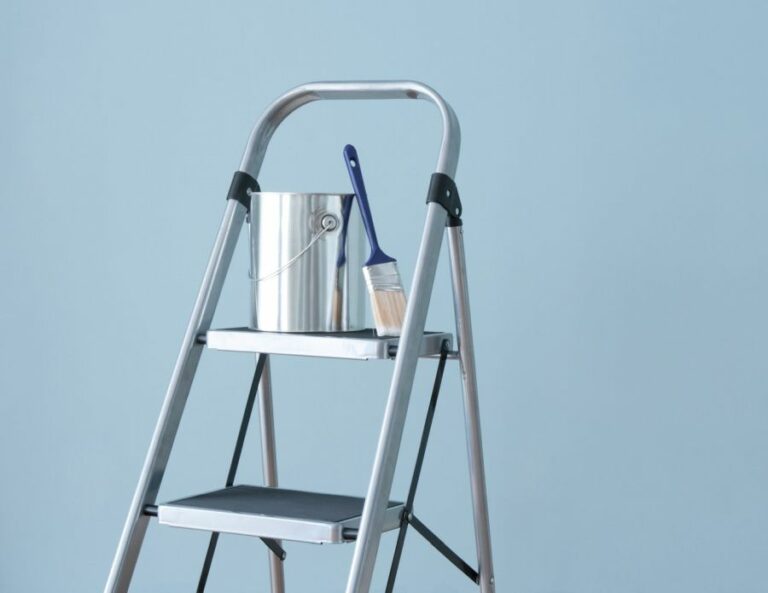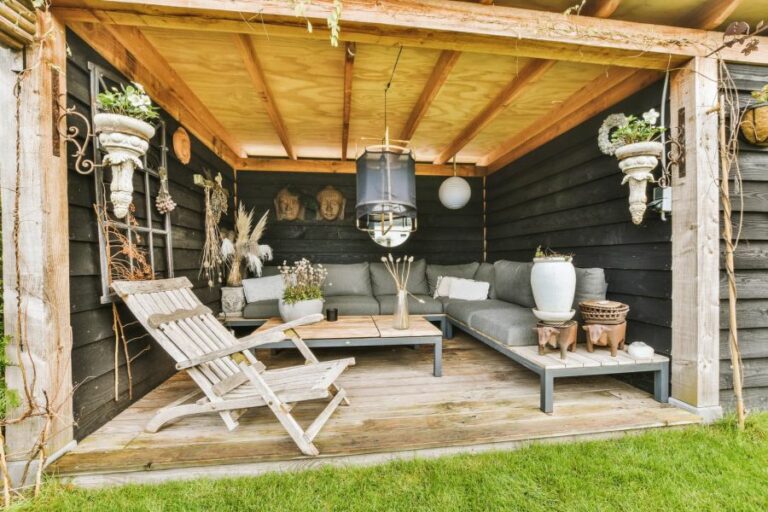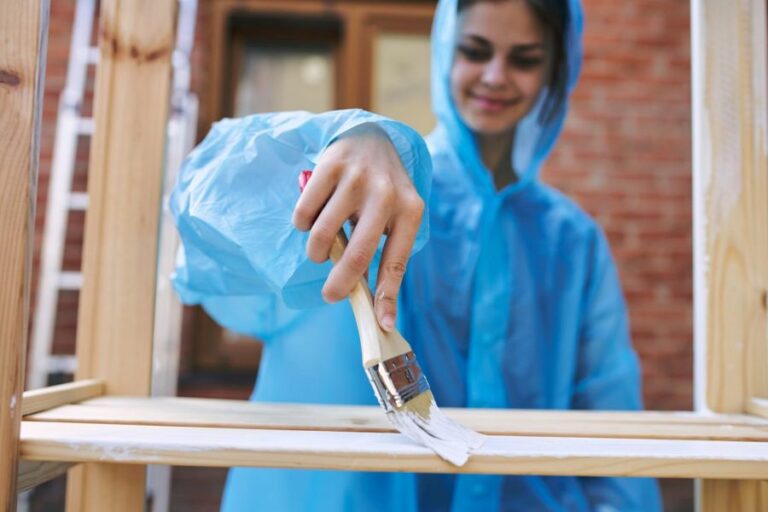Can Outdoor Paint Be Used On Metal, 25 Things You Should Know
Are you planning to give your metal surfaces a brand-new look? You might be looking for the right kind of paint, and outdoor paint might just come to mind. Discover in our blog post “Can Outdoor Paint be Used on Metal,” whether or not outdoor paint is a viable option for your metal painting projects. We will thoroughly discuss the benefits, drawbacks, and essential tips on how to use outdoor paint on a variety of metal surfaces effectively.
Can outdoor paint be used on metal:
Yes, outdoor paint can be used on metal surfaces, provided the appropriate alkyd or latex paint, primer, and painting techniques are used. Key preparatory steps include decontamination, gentle abrasion, and priming the metal surface. Proper application, uniform coverage, and sufficient drying times are vital to ensure longevity, durability, and visual appeal.

Discover the versatility of outdoor paint on metal surfaces in this comprehensive guide; learn how to prep your material, choose the right paint, and apply it for a long-lasting, eye-catching finish. Explore top tips and tricks from industry experts to ensure maximum durability and protection from the elements.
Contents
- 1 Is it Possible to Use Outdoor Paint on Metal Surfaces?
- 2 Which Type of Paint is Suitable for Application on Metal Surfaces?
- 3 What is a High-Quality Exterior Paint Suitable for Metal Surfaces?
- 4 Is it Possible to Apply Outdoor Acrylic Paint on Metal Surfaces?
- 5 What is the Duration of Exterior Paint on Metal Surfaces?
- 6 What Type of Paint is Suitable for Outdoor Metal Surfaces?
- 7 What Type of Paint is Appropriate for Use on Metal Surfaces?
Is it Possible to Use Outdoor Paint on Metal Surfaces?
• Selecting the Appropriate Paint for Outdoor Metal Surfaces
From backyard barbecues to ornate iron gates, myriad metal surfaces exist outdoors. Knowing how to properly paint these surfaces is crucial for longevity, durability, and visual appeal.
One question looms large: can outdoor paint be used on metal? The answer is affirmative, provided you make the right selections and follow the preferred techniques.
– Alkyd Paints and Their Superlative Adhesion
Alkyd paints, colloquially known as oil-based paints, possess commendable adhesion qualities. These paints contain an alkyd resin binder which forms a sturdy, impermeable barrier against external elements.
When applied to metal surfaces, alkyd paints demonstrate exceptional durability, even under the unrelenting onslaught of sun, rain, and fluctuating temperatures. As a result, alkyds make a superb choice for outdoor metal projects such as fences, garden furniture, and other metallic ornamentations.
– Latex Paints A Durable, Quick-Drying Solution
Contemporary latex paints are formulated to withstand harsh external conditions while simultaneously providing an expedient drying process. Constructed with water-soluble materials and acrylic resins, these paints confer a robust bond with metal surfaces.
Additionally, their inherent elasticity deters cracking or peeling, ensuring persistent aesthetic charm.
Developers have also enhanced latex paint formulas, rendering them resistant to ultraviolet degradation and oxidation. Discerning DIY enthusiasts may consider latex paints for their metal painting endeavors, assured of both satisfactory durability and convenience.
• Surface Preparation: An Indispensable Aspect of Outdoor Metal Painting
Before embarking on your metal painting expedition, fundamental preparatory steps cannot be overemphasized. Properly executed, these preliminary tasks ensure optimal paint adhesion, retention, and quality.
– Decontaminate: A Pristine Surface Is Paramount
Decontaminating outdoor metal surfaces is incumbent upon those desiring professional, enduring results. Vigorously scrub mild detergents over the surface to eradicate dirt, grease, or other contaminants that could hinder paint’s affinity for the metal.
Equally, consider using a pressure washer for expedient and comprehensive cleansing.
– Abrade: A Compatible Primer Is Key
Priming metal surfaces is indispensable for securing that all-important compatibility between paint and substrate. Engage in gentle abrasion with sandpaper or other suitable methodology, rendering the surface amenable to the forthcoming adhesion of the primer.
Select metal-specific primers, such as rust-inhibiting, zinc-chromate, or acrylic-based alternatives. These primers bestow metallurgical surfaces with an adhesive constitution, paving the way for the desired paint.
• Painting Techniques: The Path to a Flawless Metal Finish
Attain impressive results when painting outdoor metal surfaces by employing the appropriate techniques. Proper application, suitable quantities, and adequate drying durations are essential.
– Spray Paints: Uniform Application and Rapid Coverage
Spray painting constitutes an efficient, uniform option for applying outdoor paint on metal surfaces. After proper surface preparation and priming, utilize a sweeping, steady motion to distribute the paint.
This modus operandi enables expeditious coverage, congruous paint distribution, and an appealing finish.
– Brush and Roller Techniques: Control, Precision, and Detail
When the intricacy of design or the magnitude of the project requires precision, brushes, and rollers serve as efficacious tools. Choose the appropriate brush or roller type, size, and bristle composition based on the texture and dimensions of the metal surface.
Apply the paint in moderate amounts, taking care to spread it evenly and remove excess material. Allow appropriate drying time between coats to achieve an unblemished, refined metal finish.
• Conclusion
Unequivocally, outdoor paint can be used on metal surfaces, provided you employ the proper products, techniques, and meticulous preparation.
With alkyd or latex-based paints, primers, and skilled application processes, your metal surfaces will be rejuvenated, boasting durability and striking aesthetics for years to come. Mastering these painting principles will indubitably elevate your outdoor metal projects to the pinnacle of perfection.
Which Type of Paint is Suitable for Application on Metal Surfaces?
Discovering the perfect paint for metallic surfaces can be daunting due to the wide variety of options available. However, we’ve compiled a comprehensive exploration of the quintessential paint types, specifically designed for metal application.
Delve into the intricacies of selecting the ideal paint to ensure longevity, corrosion resistance, and an impeccable finish for your metallic masterpiece.
• Epoxy Resin Robust Protective Coating
Epoxy resin paints are synonymous with durability. These cutting-edge formulations exhibit unparalleled resistance to wear and tear, making them the go-to choice for industrial environments or high-traffic zones.
Additionally, epoxy paint boasts remarkable adhesion to metal substrates, thereby creating a tenacious bond that withstands the ravages of time.
– Advantages of Epoxy Resin
- Unrivaled strength and longevity
- Incorruptible by moisture and chemicals
- Gallant defense against rust and chipping
– Limitations of Epoxy Resin
- Eagerness to yellow when exposed to sunlight
- Complexity of application, necessitating adept execution
• Acrylic Latex Water-Based Versatility
The dawn of acrylic latex paints ushered in a new era of convenience and accessibility. Given their water-based composition, clean-up is a cinch, and environmental friendliness abounds.
Acrylic latex provides a sleek, shiny finish that expertly mimics the opulence of oil paints but with expediency in drying time. As a rust-conquering champion, this paint type thrives on outdoor metallic structures.
– Advantages of Acrylic Latex
- Streamlined application and cleanup process
- Favorable drying duration
- Resilient against UV rays and weather elements
– Limitations of Acrylic Latex
- Susceptibility to damage during initial hardening
- Potentially underwhelming opacity warrants multiple coats
• Alkyd Paint Oil-Based Elegance
Alkyd paints possess a regal bearing, bestowing an air of opulence upon any metallic surface they adorn. As a stalwart in the realm of corrosion resistance, this paint type maintains an unwavering dedication to preserving the integrity of any metallic substrate.
Creating a lustrous, enduring finish that revels in its own magnificence, alkyd paints demand veneration.
– Advantages of Alkyd Paint
- Majestic, luminous finish
- Unyielding stand against corrosion and rust
- Retains its splendor, immune to the aging process
– Limitations of Alkyd Paint
- Requires adept use of solvents for cleanup
- Astoundingly lengthy drying hours
• Polyurethane All-Encompassing Charm
Polyurethane paints are the epitome of adaptability, melding seamlessly with a wide range of substrates, including metal.
Exhibiting prolific elasticity, this paint type permits room for expansion and contraction, resulting in a finish that endures even the most tumultuous temperature fluctuations. With its quick-dry capabilities, polyurethane unites the best attributes of both oil and water-based paints.
– Advantages of Polyurethane
- Supreme flexibility for temperature variances
- Rapid drying and easy application
- Resolute defense against ultraviolet degradation
– Limitations of Polyurethane
- Volatility to moisture during the curing process
- Predisposition for inhospitable fume generation during application
• Conclusion
When selecting the optimal paint for your metal surface, consider the environmental factors, skillset required for application, and desired level of durability. It is imperative to strike a balance between the paint’s esthetic allure and functional efficacy.
With a discerning eye and steadfast resolve, you’ll triumph in the quest for the ultimate metallic paint, ensuring a resplendent and enduring finish.
What is a High-Quality Exterior Paint Suitable for Metal Surfaces?
The quest for exceptional metal paint might leave one disconcerted, but worry not, dear reader, for this guide is here to elucidate the process of choosing the most suitable exterior paint for metallic surfaces.
Shying away from platitudes, we traverse the intricate path to metal paint enlightenment, presenting to you key aspects of coatings to consider.
• Resplendent Resistance: Rust and Corrosion
When selecting first-rate metal paint, the triumph over rust and corrosion is paramount. Thus, opt for formulations containing anti-corrosive elements or primers packed with rust-inhibitive properties.
- Alkyd Paint: Flourishing in durability, alkyd enamels offer long-term fortification against wear, tear, and weathering. These oil-based concoctions may, however, emit undesirable fumes while drying.
- Acrylic-Modified Latex Paint: A composite born from science, acrylic-modified latex brandishes superlative water resistance and adhesion. Plus, it bestows upon the painted surface a low-odor facade that is kind to the environment.
- Direct-to-Metal (DTM) Paint: An all-embracing solution merging both primer and paint, DTM ensures maximum adhesion and rust preclusion. A distillation of convenience with robustness, bestowing a timely and cost-effective route to metal protection.
• Weathering the Tempest: Robustness Against Mother Nature
As Hesiod once wrote, “Observe due measure, for right timing is in all things the most important factor.” With this wisdom in mind, one should opt for quick-drying paint that can withstand tumultuous elements.
- Urethane-Modified Acrylic: A formidable contender, urethane-modified acrylic boasts steadfast adhesion, swift drying, and low-VOC emissions. These triumphant properties make it apt for a hurried application amidst disturbance from the heavens above.
- Waterborne Acrylic: Propelled by the wings of science, waterborne acrylics possess remarkable color and gloss retention. They offer prime resistance against oxidation, embrittlement, and the unremitting ravages of time.
• Adherence Mastery: Gripping onto Metal Surfaces
The bonding prowess of metal paint makes it reliable and lasting, preventing a swift descent into an unsightly visage of peeling and chipping.
- Epoxy Primers: A maestro in adhesion, epoxy primers excel in bonding to metals, creating a barrier impervious to water, chemicals, and solvents. However, note that epoxy primers might dull over time, making them most suitable as base coats.
- Self-Etching Primers: With their ability to permeate and etch metal surfaces, self-etching primers proffer potent adhesion and corrosion denial. Nonetheless, it is advisable to use them conjointly with top coats for heightened durability.
• A Symphony of Color: Aesthetic Appeal and Variety
While one may acquiesce to the technicalities of paint, let us not forget the vigor and vivacity that a stunning hue can bring forth. Peruse color options, mindful of factors such as fading and chalking, seeking coatings that radiate brilliance and longevity.
- Polyurethane Paints: With their roots entrenched in industrial applications, polyurethane paints emerge as bearers of awe-inspiring gloss and color retention. Delve into these vibrant choices for a captivating cacophony of hues that sing out to the senses.
- Fluoropolymer Coatings: Behold the marvels of chemistry as fluoropolymer coatings unfurl a variegated palette of colors cloaked in UV resistance. With their exceptional resilience against chalking, they make for illustrious speculations.
In summation, a quality exterior paint for metal surfaces should embody corrosion resistance, robustness against inclement weather, superior adhesion, and aesthetic allure.
With steadfast determination and armed with newfound knowledge, you are now prepared to embark on a journey toward the superlative paint choice for your metal surfaces.
Is it Possible to Apply Outdoor Acrylic Paint on Metal Surfaces?
• Exploring Your Creative Opportunities
A frequently pondered enigma by both novice and seasoned artists is whether it’s plausible to employ outdoor acrylic paint on metal surfaces. If you’re seeking to embark on a project that entails the melding of these two entities, allow us to shepherd you on this artful expedition.
– Tackling the Metal Conundrum
Indeed, the usage of acrylic paint on metal is achievable and propitious for a myriad of projects. The flexibility and robustness of outdoor acrylic paint provide an alluring proposition that warrants exploration.
However, a crucial factor to consider is the meticulous preparatory work required for an enduring and visually enthralling result.
Metallic Surface Medley: Priming is Paramount
To safeguard against haphazard adherence, peeling, or fading, ensuring your metal surface is appropriately primed is a requisite step. Thus, establishing a harmonious union between the paint and the metallic canvas.
Let us delve into the tried-and-true methods to achieve an impeccable foundation for your masterpiece.
- Eradicating Rust and Corrosion: If the metal surface is besieged by oxidation or corrosion, utilizing a wire brush, steel wool, or sandpaper to efface these afflictions is of the utmost importance. Neglecting this procedure may lead to extraneous debris compromising paint adhesion.
- Surface Degreasing: The presence of grease or oil on the metal may engender a displeasing dissonance between the paint and the substrate. Employing a solvent-based cleanser infused with fastidious intent will reign victorious in banishing these malevolent particles.
- Abrading the Metal: To bolster the steadfast bond between the paint and metal, utilizing fine-grit sandpaper or sanding pads is a sage decision. Strive for a matte appearance on the surface, which signifies the desired degree of roughness.
- Metal Etching Primer: An indispensable component in this creative journey is the application of a metal etching primer. This alchemical potion ensconces the metal’s surface, offering an idyllic setting for the paint to thrive. Decorous attention to dry times and primer layer thickness is indispensable for a successful endeavor.
– Spanning the Spectrum: Choosing an Apposite Acrylic
Once the metallic surface is aptly prepared, adorning it with the appropriate acrylic paint is the subsequent stage in your artistic undertaking.
Fathom the importance of selecting high-quality outdoor acrylic paint that is specifically designed for metal. This wise choice ensures durability, UV resistance, and elemental endurance.
Integrating Additives for Astral Allure
Introducing additives to your acrylic paint can elevate your creative prowess and endow your masterpiece with an unmatched singularity. Some noteworthy considerations:
- Anti-Slip Additive: When applying paint to metallic surfaces with functional purposes (such as stair treads), an anti-slip additive prevents the surface from becoming a treacherous terrain.
- Texture Medium: Embellishing your paint with artful texture invites an intriguing visual dialogue between creator and spectator.
– Metal Masterpiece Manifestation: Techniques for Acrylic Application
To manifest your artistic vision, consider these innovative techniques for an expressive and captivating outcome.
- Basic Brushwork: A classic, tried-and-true method. Enhance the vivacity of your strokes by employing brushes of varying sizes, shapes, and bristle densities.
- Dabbing: Implement sponges or fabric for an entrancing stipple effect that interweaves an intricate depth to your creation.
- Drips & Splatters: Unleash your inner Pollock and introduce an abstract element to your artwork by employing this audacious yet mesmerizing approach.
- Palette Knife Painting: Embolden your metallic canvas with assertive texture and expressive dimension by wielding the versatile palette knife.
– Prolonging Metal-Paint Amity: Seal with Varnish
Concluding your creative endeavor with a protective varnish will fortify the union between paint and metal. This invaluable measure defends against disintegration and fading, ensuring a long-lasting artistic alliance.
In conclusion, venturing into the realm of acrylic paint upon metal surfaces is undoubtedly achievable and rewarding. Armed with these essential insights, your journey to create a sublime metal masterpiece is poised for resplendence.
What is the Duration of Exterior Paint on Metal Surfaces?
Painting metal surfaces, be it your home’s wrought iron railings, garden furniture, or an industrial warehouse, provides conspicuous benefits. Not only does it vivify their appearance, but it also bolsters the material’s durability.
However, with time, even the most fastidiously applied coats fall prey to the ravages of wear and tear.
• Variables That Impact Exterior Paint Endurance on Metal
1. Paint Type and Quality
The type of paint utilized plays a pivotal role in determining the lifespan of the paint on metal surfaces. High-quality paints burgeon the endurance, offering better protection from corrosion, UV rays, and inclement weather.
Alkyd, latex, and epoxy-based paints are among the preferred options for metal surfaces due to their adhesiveness, resilience, and water resistance.
- Alkyd Paints: Heralded for their impressive durability and glossy finish, alkyd paints proffer substantial resistance to weather and abrasion. Perfect for ferrous metals, their oil-based formulation imparts commendable corrosion prevention, lasting between 8-10 years.
- Latex Paints: Comprising water-soluble acrylic binders, latex-based paints exhibit excellent adhesion and durability. Rapid drying time and minimal VOC emissions further bolster their appeal for outdoor projects. However, their longevity on metal surfaces, on average, spans 6-8 years.
- Epoxy-based Paints: Boasting unparalleled adhesion and resistance to chemicals, epoxy paints are the sine qua non of industrial applications. However, this longevity necessitates meticulous application and cure time. Once correctly applied, they can sustain for over a decade.
2. Surface Preparation and Application
Cavils aside, thorough surface preparation lays the cornerstone of successful exterior painting endeavors. Prior to painting, assiduously remove rust, dirt, and flaking paint using a wire brush, sandpaper, or a power washer.
Next, apply a rust-inhibiting primer for added protection and to ensure stellar adhesion of the topcoat. A well-prepped metal surface augments paint endurance, averting premature deterioration.
Additionally, employing the proper paint application technique, whether brushing, rolling, or spraying, bears considerable weight on the final outcome. A smooth, even coat prevents water ingress and condensation, which, left unchecked, catalyzes corrosion and paint degradation.
3. Climatic Factors and Weather Patterns
External elemental vagaries inflict deleterious effects on metal surfaces and affect the efficacy of exterior paint. Regions with high precipitation, blistering sun, or biting frost propagate faster depreciation of the paint job, shortening its lifespan.
Conversely, temperate climes with moderate precipitation and mild temperature fluctuations extend paint life considerably.
4. Maintenance and Upkeep
Vociferously underrated, routine maintenance is the linchpin of preserving and prolonging the life of exterior paint on metal surfaces. Inspect the painted metal for early signs of rust and paint peeling, and take timely action.
Periodic cleaning with mild soap and water, due diligence in addressing damage, and touch-ups fend off the insidious march of corrosion and maintain paint integrity.
• Optimal Measures to Prolong Exterior Paint on Metal
- Select top-quality paint: By opting for high-quality, weather-resistant paint designed for metal surfaces, you strengthen its longevity and resilience against the elements.
- Employ a high-performance primer: Using a rust-inhibiting primer tailored for metal provides a robust foundation, enhancing paint durability.
- Adhere to surface preparation protocols: Meticulous surface preparation, including rust removal and cleaning, fosters optimal paint adhesion, mitigating premature deterioration.
- Implement routine maintenance: Regular inspections, cleaning, and touch-ups stave off paint degradation and bolster lifespan.
In conclusion, myriad factors steer the longevity of exterior paint on metal surfaces. With judicious decisions, diligent surface preparation, and conscientious maintenance, it is feasible to attain an exterior paint life of 8-10 years or more.
With this comprehensive roadmap at your disposal, embark on your metal painting journey with newfound confidence and expertise.
Type of Paint | Average Lifespan |
|---|---|
Acrylic Latex | 5-10 years |
Oil-Based | 10-15 years |
Alkyd | 7-12 years |
Epoxy | 10-20 years |
What Type of Paint is Suitable for Outdoor Metal Surfaces?
Outdoor metal surfaces demand a precise blend of paint to withstand the vagaries of the elements without compromising on their charming aesthetic. Choosing the right paint for metal outdoors requires a discerning eye and an intimate understanding of the materials’ innate characteristics.
• Deciphering the Metal’s Mystique
The nitty-gritty of choosing the right paint begins with the understanding of the metal in question. Esteemed metals such as wrought iron, aluminum, and galvanized steel behave differently under the relentless caress of Mother Nature.
Comprehending their quirks and susceptibilities will inform your choice of paint and ensure that your metal ornaments retain their charm for eons.
– The Alchemical Allure of Wrought Iron
Wrought iron, a perennial favorite for exquisite garden furniture and gates, is revered for its pliability and sturdy constitution. However, its Achilles’ heel lies in its proclivity for rust. To vanquish this insidious enemy, opt for a rust-inhibiting primer followed by a durable, water-resistant topcoat.
– Aluminum’s Effervescent Elegance
Aluminum, a lightweight wonder known for its anti-rust proclivities and contemporary brilliance, makes for the perfect addition to swanky patios and modern verandas. A self-etching primer is a mandatory precursor to painting aluminum, as it etches the surface for optimal paint adhesion.
Employ an acrylic latex exterior paint as the coup de grace for a vibrant, enduring finish.
– Galvanized Steel’s Unfaltering Fortitude
The unique amalgamation of zinc and steel in galvanized steel bestows it with unparalleled corrosion resistance in punishing climates. Utilize a galvanized metal primer to underscore this inherent strength, and choose an alkyd or acrylic-latex topcoat to safeguard its lustrous sheen.
• The Creme de la Creme: Selecting the Ideal Paint
The meticulous methodology employed in choosing the ideal paint for your metallic outdoor surfaces revolves around two pivotal categories oil-based and water-based paints.
– The Ageless Aristocrat: Oil-based Paints
Oil-based paints, an enduring classic known for their tenacious adherence and indomitable durability, have been the backbone of impeccable outdoor finishes for centuries. Brands like Rust-Oleum and Krylon offer enamoring oil-based options that meld regality and resilience.
Such paints possess the inherent ability to expand and contract with the metal’s temperature fluctuations, ensuring a coat that will last for generations.
– The Aquatic Ascendancy: Water-based Paints
Water-based, or acrylic-latex, paints are the avant-garde alternatives to their oil-based brethren. Boasting a low VOC (Volatile Organic Compound) count, these paints are environmentally friendly and significantly easier to clean.
Their quick-drying nature and durability make them an alluring option for eco-conscious individuals. Brands like Sherwin-Williams and PPG offer an oeuvre of water-based options for intrepid decorators to explore.
• Essential accoutrements: Primers and Topcoats
The astute decorator knows that a prolific paint job goes beyond the color selection. Employing the optimal primer and topcoat are paramount to a coating that not only captivates but also endures.
– Primers of Preeminence
Primers designed specifically for metal work wonders in preparing the surface for the paint to cling. Rust-inhibiting primers, galvanized metal primers, and self-etching primers are the holy trinity that paves the way for flawless adherence and longevity.
– The Tantalizing Topcoat
With options such as urethane and acrylic resin topcoats boasting their UV resistance and enviable longevity, your outdoor metal surfaces will gleam under the sun, rain, and snow alike.
And so, with a discerning eye and a penchant for detail, you can select the perfect paint for your metal surfaces outdoors.
Whether it’s an elegant wrought iron gate or an ultramodern aluminum pergola, these nuggets of wisdom will ensure that your pièce de résistance maintains its splendor through the sands of time.
What Type of Paint is Appropriate for Use on Metal Surfaces?
Painting metal surfaces poses distinct challenges compared to painting other materials. Knowing the optimal paint to use is crucial to ensure a lasting, brilliant finish.
• Sublime Epoxy Paints: Unparalleled Durability
Epoxy paints are renowned for their exceptional tenacity and resilience. These coatings boast a top-tier adhesion property, forming a tight bond with metallic surfaces.
The bipartite composition of epoxy paints renders them impervious to myriad environmental threats, rendering them an ideal choice for outdoor applications.
In addition to providing a robust barrier against corrosion, epoxy paints exhibit remarkable resistance against chipping or peeling. Surfaces treated with epoxy can withstand considerable wear and tear, ensuring a sublime finish despite the rigors of time.
• Alkyd Enamels: Trademark Luster and Gloss
Alkyd enamels are acclaimed for their capacity to generate an alluring, high-gloss sheen. Employing a potent blend of resin, binder, and pigment, alkyd enamels proffer a distinctive aesthetic appeal that is sure to captivate.
Moreover, alkyd enamels afford metal surfaces a substantive degree of protection from corrosive elements. This value-added feature makes alkyd enamels particularly suited for enhancing the longevity and vibrancy of metal surfaces exposed to adverse conditions.
Despite the potential for slower drying times, the supreme luster and effective shield against oxidation make alkyd enamels a veritable contender for any discerning painter.
• Acrylic Latex Paints: Versatile and Eco-Friendly
Offering a paint solution that balances practicality with sustainability, acrylic latex paints champion environmental safety. Propelled by a water-soluble base, these paints emit minimal volatile organic compounds (VOCs) and are, therefore an eco-conscious choice for painting metal surfaces.
Acrylic latex paints proffer a formidable option for metal, as they deliver reliable adhesion and exhibit commendable resistance to chipping and flaking. Moreover, the swift drying times associated with these paints contribute significantly to their convenience and efficacy.
• Direct-to-Metal (DTM) Paints: Expedient and Uncomplicated
Designed to eliminate the need for primer, direct-to-metal paints provide a one-step solution that streamlines the metal painting process. The intrinsic primer properties augment the paint’s adhesion capabilities, allowing for optimal bonding with the metal surface.
If you demand a paint that simplifies application while also providing a long-lasting and formidable finish, direct-to-metal paints could serve as the perfect solution.
• Considerations for Paint Selection
– Surface Preparation
A thorough surface preparation is paramount to ensuring the successful application of any paint. Metallic surfaces should be decontaminated, cleared of loose paint or rust, and sanded to guarantee utmost adhesion.
– Primer Application
Applying a primer before painting enhances the paint’s stability and provides an additional layer of protection. Certain paint types we mentioned call for primers, while others, such as direct-to-metal paints, do not necessitate this additional step.
– Environmental Influences
Considering the environmental conditions to which the metal will be exposed is integral to the paint selection process. Some paints offer exceptional outdoor performance, while others might be better tailored for indoor use.
– Aesthetic Preferences
Finally, the desired sheen or finish you seek will significantly influence your choice of paint. Gloss, matte, or textured options are available to suit a gamut of stylistic preferences.
Armed with this knowledge, you’re prepared to make an informed decision in selecting the optimal paint choice for your metal painting project. Keep these tips in mind and watch as your metal surfaces transform into resplendent, enduring works of art.
Paint Type | Description |
|---|---|
Acrylic Latex Paint | Water-based paint with easy clean-up and low odor. It offers excellent adhesion to metal surfaces and dries quickly. |
Oil-Based Paint | Provides a durable finish that can withstand weather and wear. It offers great coverage and takes longer to dry, allowing for a smoother finish. |
Alkyd Paint | An oil-based paint that offers a hard, glossy finish that resists chipping and peeling. It’s ideal for outdoor metal surfaces. |
Enamel Paint | This paint type offers a hard, glossy finish that is resistant to weather and wear. It can be either oil-based or water-based, depending on the brand and formulation. |
Epoxy Paint | A two-component, heavy-duty coating that is extremely durable and resistant to chemicals, abrasion, and corrosion. It’s ideal for industrial metal surfaces or areas exposed to harsh environments. |
Direct-to-Metal (DTM) Paint | These paints are specially formulated to bond directly with metal surfaces without the need for a primer. They offer excellent durability and protection against rust and corrosion. |

